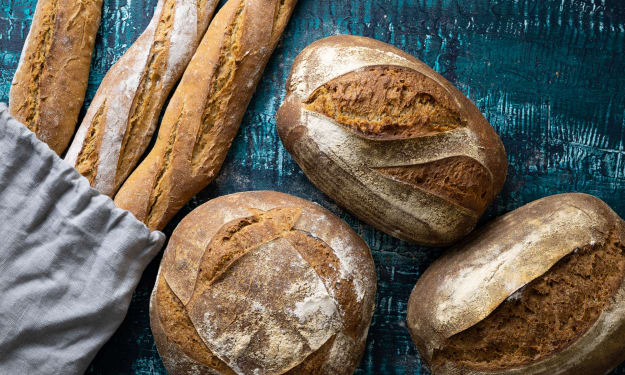Takuan, How to Make it, and the Language of Food
This popular sushi side dish is super simple to make

I have no memories of Japan. Fleeting tourists are on far more intimate terms with my ancestral landscape. Any first year student in the first week of class knows as much of the language as I do, and will likely surpass my abilities by the second week, despite my ongoing Duolingo attempts. I cannot perform a tea ceremony or the Bon Odori dance to honor my ancestors, and I haven't a clue how to wear a kimono.
But chopsticks are as familiar as forks and I speak the language of the food.
It's an interesting language, made up of words, motions, kitchenware, traditions, gestures, and ingredients. It varies and evolves and is mindful of seasons. Families speak their own variations.
In a childhood where I couldn't count on much other than volatile tempers, the Sunday night language of my father's sushi rolls was the calmest eye in the center of the storm. Quiet, calm, and precious, filled with cucumber, tamagoyaki (egg omelet), and fish. Nothing bad could happen while "The Wonderful World of Disney" aired and sushi remained on the platter.
I learned the fragrant language of my uncle frying Spam for breakfast, the clicks and steam of the rice cooker, the soft, swift sounds of aunties rolling lumpia. I felt it in my wet and sticky palms while making rice balls. I slurped it up with thick and chewy udon noodles.
Traveling opens up a big, wide world but food shrinks it down to the here and now, demanding attention in the moment to tastes and textures, sights and smells. A big pot of sukiyaki in the middle of the table can take you to Tokyo no matter where your table is actually located, but you'll be focused on the bubbling broth, steaming vegetables, and dipping the just-barely-cooked beef into a beaten raw egg. The flavor of umami is its own language.
While pickles don't qualify as umami or for their own language, to me they are important adjectives. Tsukemono (pickled vegetables) enhance and complement meals. They cleanse the palate, provide contrast, and balance flavor profiles, and my favorite vocabulary word is "takuan" (tah-koo-on).
But don't tell anyone. When a foreign food becomes popular here in the U.S. the price goes up, and daikon radish is not that expensive because it's not as well known. If you haven't had it, it's milder than red radishes, and is great shredded into salads or sliced into stir-fries. But the pickles are the best.
Growing up we visited a small Japanese restaurant in Seattle called Tenkatsu about once a month. Our honorary obasan (auntie) served us beautiful Japanese home cooking meals -- the type that were kind of hard to find for a while when the sushi craze became a thing. And are probably still kind of hard to find in some corners of the country. Every meal started with miso soup and tiny dishes of takuan, oshitashi (sesame spinach salad) slices of fish cake, and sunomono (lightly pickled cucumber salad). Every single meal, without fail. Then a big, shareable bowl of rice would follow, along with the entrees. As children, my sister and I would invariably order either tempura or beef teriyaki -- the old school kind of teriyaki that's just the meat swimming in a sweet, salty sea of thin teriyaki broth. You can’t really find that any more. Or Tenkatsu. It's always a little sad when languages evolve and words are left behind.
Takuan is pickled daikon radish, and the traditional Japanese version not only takes months to prepare, it takes a few weeks of warm sunshine -- not exactly an abundant commodity here in Seattle. I also don't have a place to bury them underground in a crock full of rice bran. Luckily, there’s a quick and easy way to make them as refrigerator pickles. No water bath or pressure canning involved and the ingredients are common. Well, daikon may or may not be common where you are. You can find it in most major metropolitan areas and/or areas with Asian communities or grocery stores. It’s in all of our major grocery stores here in Seattle.

Takuan Recipe
Ingredients (halve, double or triple depending on how much daikon you have)
1 large, long daikon radish (about 1/2 pound)
1 tbsp salt + 1 tsp salt
½ cup rice vinegar (not sushi vinegar)
1 cup water
½ cup sugar
½ tsp ground turmeric
Directions:
Peel the daikon and trim the ends. Cut into thin rounds between 1/8 inch and ¼ inch. If your daikon is really big around, cut the daikon lengthwise and cut into half circles.
Put the daikon in a bowl and sprinkle with 1 tablespoon of the salt. Mix well and let sit for 15 minutes, then rinse the salt off and let drain in a colander.
In a small saucepan combine the rest of the ingredients. Heat over medium heat, stirring, until the sugar, turmeric and salt have dissolved (the turmeric may not fully dissolve and that’s okay). Take off heat and let cool to room temperature.
Stuff the daikon slices into a jar that will fit them. Any jar will do, but be sure to sterilize it first. Pour the liquid into the jar over the daikon. Leave 1 inch of room at the top because the radishes will release some liquid as they pickle. Don’t worry if there’s not enough liquid to cover the daikon at first. Shake the jar each day to distribute everything.
Put a lid on the jar and store in the refrigerator for at least 2 days before eating. 5 is better. The pickles will last about a month if you can keep your hands out of the jar. I can’t.
Note: After purchasing the daikon, let it sit in your vegetable crisper for a few weeks. It makes better pickles when it’s aged and starting to get limp. Unlike just about everything else.

What to Eat Takuan With
Serve them in little dishes with other little appetizers. Eat them with rice. Order sushi takeout and eat them on the side. Slice them and add to salads. They’re really great on tuna fish sandwiches and pork tacos. No, really, I’m seriously serious. Think about anywhere you’d use pickled onions or peppers and use these there.
About the Creator
Maria Shimizu Christensen
Writer living my dreams by day and dreaming up new ones by night
Also, History Major, Senior Accountant, Geek, Fan of cocktails and camping






Comments
There are no comments for this story
Be the first to respond and start the conversation.